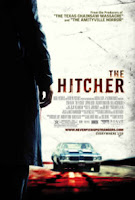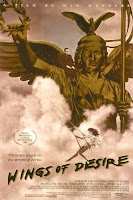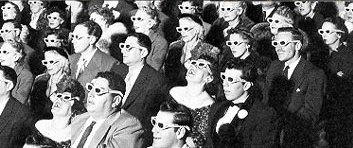
Assessment Task 3 – Analysing Mulholland Drive
David’s Lynch’s Mulholland Drive is a movie that he wrote and directed as a television pilot, before turning it into a feature film. Lynch’s work, which includes television, film, art and multimedia, regularly involves heavy usage of symbolism. Mulholland Drive is a prime example of this. The film’s use of symbolism has left the film with a typically Lynchian feel of unknown. There doesn’t seem to be one theory for the film that ties everything together, but instead there are hundreds of individual interpretations on the film. Lynch’s desire to never speak of the true meaning of the symbolism in Mulholland Drive only goes to intrigue viewers even more.
Two characters we meet early in the film are an old couple that travelled with the leader character of Betty from Deep River Ontario to Los Angeles. One theory involving these characters is that they represent “erinyes”. These figured are present in Greek mythology and act as pursuers of criminals. Mythology tells us that these erinyes (pronounced “I-rin’ee-eez”, which sounds like “Irene”, the name of the old lady) pursue wrongdoers relentlessly until they are driven mad and commit suicide. This theory fits into Mulholland Drive as the final scene of the movie features the old couple returning and for seemingly no reason tormenting Betty (who at that point has become the character Diane in a role-reversal) until she grabs a gun and kills herself.
Similarly, the old couple could also represent the innocence of Betty/Diane’s past in Deep River, before she came to Los Angeles. They represent wholesome values (they are first seen awarding Betty a first prize at a jitterbug competition, yet another sign of Lynch’s fetish for twisting 1950s into modern day evil) and their return at the climax of the film symbolises Diane’s grief over a criminal act. She feels her past coming back and knowing she can’t turn back, which leads to her committing suicide.
The character of the monster behind the Winkie’s restaurant (actually just a homeless person) is another one steeped in possible symbolism. His arrival in the film comes just as one man dies. The homeless man could represent many things, but I think it is one of two. The man acts as a physical embodiment of Betty/Diane’s guilt over the criminal act I discussed earlier (the criminal act being the hiring of an assassin to murder her former lover Camilla). The guilt that Diane feels is so great that it can kill an innocent man who merely looks at him.
At the same time it represents the failure on her part to become the “movie star” or “actress” that she came to Los Angeles to be. David Lynch uses the film to act as an essay on the way Hollywood treats (and mistreats) women such as Betty/Diane. The homeless figure, in such close approximation to one of the highlights on LA – Sunset Boulevard, just exemplifies this. Acting as a sort of second representation of Betty/Diane herself, it shows that no matter how close to fame and fortune she would get, she was doomed from the start. That the homeless man is a harbinger of death it seems (every time he appears a character dies), just further proves that Betty/Diane was doomed from the start. Where she goes, death follows.
A scene involving a man and his psychiatrist takes place at the Winkie’s restaurant before the homeless man kills the patient mysteriously. This patient is seen later in the film in the segment where Betty has become her real persona, Diane. He is merely a man in the restaurant at the time that Diane meets with the hired killer. This proves that the homeless man that appears behind Winkie’s is the manifestation of Diane’s guilt. The man says to his psychiatrist that it can see through walls. I take this as meaning that Diane’s guilt is so large and overpowering that it holds no boundaries. That the homeless man kills the patient merely by looking him is another clue that the guilt Diane feels is so powerful that it can kill a single person for no reason, other than he was there at the time that the guilt was formed.
David Lynch’s casting proves to be symbolism in itself. In Mulholland Drive actresses who have appeared on television soap operas play four of the female characters. Laura Elena Harring (Camilla/Rita) appeared on General Hospital and Sunset Beach while Naomi Watts (Betty/Diane), Melissa George (Camilla) and Elizabeth Lackey (Carol) all appeared on Home & Away. The themes of mistreatment of actresses seems to be the prime reason behind this decision, as his two lead actresses (Watts and Harring) had never proven to be thespians of the highest quality.
Lynch’s casting of these soap opera stars is particularly sneaky because that is a genre of programming that is routinely mocked and made fun of (Lynch’s love of the field could be seen clearly in his own television series “Twin Peaks”). Another trademark of Lynch is the casting of musicians (in Mulholland Drive’s case it’s Billy Ray Cyrus and Rebekah Del Rio), another group of people who are routinely mocked when it comes to acting. Lynch uses these groups to symbolise how Hollywood routinely dumps them when they are no longer useful (aka, no longer beautiful or selling records). They represent anybody who has ever been in a similar position. That the film shows the trials of a woman who came to Hollywood with big dreams, but then got them effectively stomped on, is ripe.
The red lamp is a key feature in the film, appearing at several moments throughout the film. The red light could represent prostitution, a theory that is two-fold. It could symbolise Diane’s descent into being a prostitute of the Hollywood system. Getting cast as an extra in a movie that her ex-lover Camilla has the lead in, or just generally doing whatever she can to survive in the industry. It could also be a very literal clue as to where the character of Diane is in life. Having struck out in the movie business she would very well have become a prostitute. A possible key to this theory is the character of Mr Roque, a mysterious man who could symbolise her boss (pimp, if you will). Diane routinely receives phone calls from men connected to Mr Roque. A red lamp appears in another scene involving a hit man and a prostitute, another clue lending credence to this theory.
The club that Betty and Rita attend is Club Silencio, a strange place that bares a lot of resemblance to the Red Room from Twin Peaks. With it's red drapes, the “music in the air” and the loss of reality – in the red room characters can float, at Silencio they can vanish. I believe Club Silencio acts as a coping mechanism for the real Diane as she starts to wake up from her dream-filled sleep. I believe it acts as a way of telling Betty (Diane’s imagined self) that not all is as it seems and that what she’s experiencing isn’t actually real, but is indeed a dream. Characters speak, play instruments and sing, yet we are merely listening to a pre-recorded tape and actors are playing out the roles.
Among the characters we see at the club (all of which appear elsewhere in the film as manifestations of Diane’s subconscious), Rebekah Del Rio is a singer who performs Roy Orbison’s “Crying” in Spanish. Her performance appears so real that Betty and Rita start crying, yet even though we have already been told is it all “a recording” they forget this, further proving that Betty thinks what she is experiencing is real. Del Rio soon collapses and the music keeps playing, pointing to Diane that not everything she is seeing and hearing can be trusted. It is at this moment that Betty notices the blue box in her bag.
The blue box is one aspect of Mulholland Drive that causes much debate. Continuing on the theory that Betty doesn’t really exist and is an idealised figment of Diane’s imagination, it would be logical to say that the blue box symbolises a sort of Pandora’s Box. Just as Rita/Camilla is about to open the box with the blue key she possessed at the start, Betty disappears. Again, continuing on the theory that the entire film is Diane’s dream, this makes perfect sense. The appearance of the box along with the blue key, which we later discover was the calling card left by the Diane’s hired killer, makes Diane, still dreaming, start to realise what she has exactly done. You could say that all the puzzle pieces have come together.
When Rita turns the key the camera literally zooms inside and from then on it’s as if we’ve entered the real world of Diane, possibly as she comes further out of her dream world and closer to consciousness. The theory that the box is a Pandora’s Box holds up because once it is opened Diane starts to recognise the enormity of the situation and from then one we start to see the real story of Diane and Camilla – or, as real as Diane’s dream will allow us to see. In one scene, the old couple (the perceived erinyes) are seen, in miniatures, crawling out from the blue box as it drops to the ground from the hands of the homeless man. This doppelganger of symbolism suggests that, in my interpretation, the homeless man is indeed the manifestation of her guilt and that the Erinyes are emerging from Pandora’s Box to torment Diane.
One character that appears at Club Silencio is the near-unnoticed blue-haired lady. It is not until the very final moments of the film that you realise she was in the club scene, sitting up in her balcony spot observing the proceedings. I believe her presence is the key to unlocking the secrets of the film. The last frames of the film are of the blue-haired lady drowned in blue light whispering the word “Silencio” and nothing else. I think this tells us the Club Silencio scene is the moment we should focus our attention on. It would symbolise that everything, and that’s including the second half of the scene which is apparently the “real” story, isn’t to be believed. It is indeed one big dream of Diane and you can never believe everything that occurs in the dream. For all we know Diane could have been a much worse person than she sees herself.
The blue-haired lady could also be Lynch’s ethereal representation of God. A mysterious and omnipresent creature that stays above everybody and everything, possibly manipulating or guiding the people below, but ultimately proving to be a powerless entity. If that is the case, then the pseudo-magician to takes centre stage at Club Silencio could represent the devil. The magician appears to have powers of manipulation that he is actively using on Betty and Rita. Just as the blue-haired lady is seen to sit above the audience, the magician stands on the stage below the audience, working his magic on the crowd. This symbolism could further represent Diane’s descent into Hell, luring Betty/Diane down to him as God, the blue-haired lady, sits aloof above them. It is not God’s responsibility for the likes of Diane to not sin, but it is the Devil’s business to lure her to his side.
One of the major theories that holds much water is that the character of Diane suffered from abuse as a child. There are many symbolised clues to attest to this theory. At the end of the film as the old couple are chasing Diane through her house there is a quite audible moment when the viewer can here the simultaneous cry of a little girl and an older man. The audition scene involves Betty auditioning for a role as a character who has an affair with “Dad’s best friend”. In Twin Peaks Laura Palmer’s murderer (and sexual abuser) was Bob, or “Dad’s best friend”. But “Bob” was actually the identity that Laura saw in her mind, when it was really her father molesting her.
Other clues include when Betty says she comes from Deep River Ontario. In David Lynch’s 1986 film Blue Velvet that character played by Isabella Rossellini lives in the Deep River Apartment block where she is routinely sexually and physically abused. The character of Rita in Mulholland Drive takes her name (when she can’t remember her real one) from a Gilda poster. Gilda starred Rita Hayworth who was known to have been sexually abused as a child by her father. And most significantly, I think, is when Diane and Camilla are on the couch in her apartment, Diane gets sexually violent and it is said that abuse victims are more likely to become abusers than those who weren’t. Lastly, the film within the film is called The Sylvia North Story seemingly set in the 1960s. In 1965 a film was released called Sylvia about a character called Sylvia West who was raped by her stepfather and then later became a prostitute. This also puts weight behind the theory of Diane becoming a prostitute in life after her acting dreams failed.
There are many more examples of symbolism throughout Lynch’s masterpiece, but the beauty of it is that you never can quite tell what are symbols are what are merely Lynch playing games with his audience. There is very solid evidence that supports the theories that people have come up with since the film’s release in 2001. It isn’t hard to believe thought that Lynch put everything in for a reason and that the symbolism works on multiple levels so people can get different meanings. Lynch’s use of symbolism is a trademark that he continuously uses throughout his work and it is all part of the tapestry of one of his pieces.






No comments:
Post a Comment